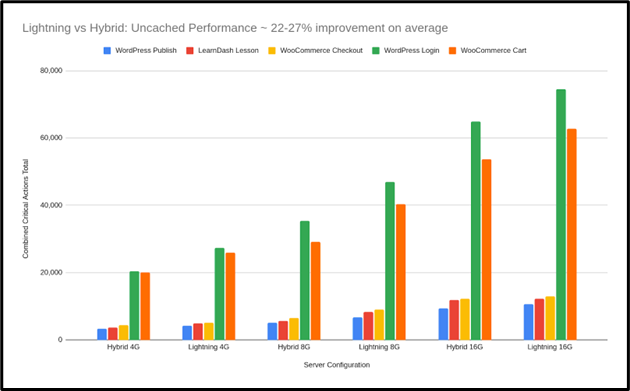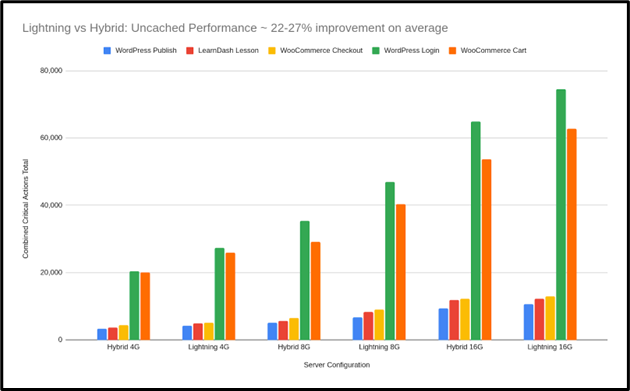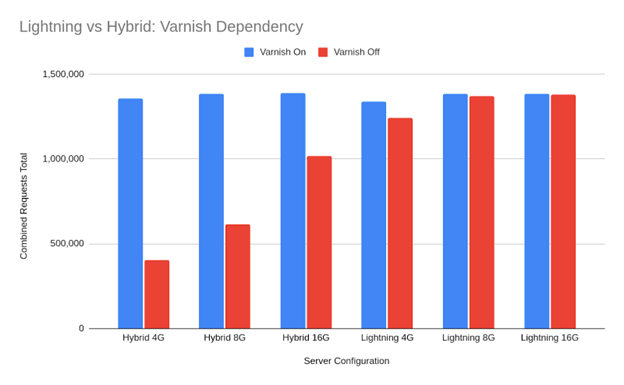This post was sponsored by Cloudways. The opinions expressed in this article are the sponsor’s own.
Wondering why your rankings may be declining?
Just discovered your WooCommerce site has slow load times?
A slow WooCommerce site doesn’t just cost you conversions. It affects search visibility, backend performance, and customer trust.
Whether you’re a developer running your own stack or an agency managing dozens of client stores, understanding how WooCommerce performance scales under load is now considered table stakes.
Today, many WordPress sites are far more dynamic, meaning many things are happening at the same time:
- Stores run real-time sales.
- LMS platforms track user progress.
- Membership sites deliver highly personalized content.
Every action a user takes, from logging in, updating a cart, or initiating checkout, relies on live data from the server. These requests cannot be cached.
Tools like Varnish or CDNs can help with public pages such as the homepage or product listings. But once someone logs in to their account or interacts with their session, caching no longer helps. Each request must be processed in real time.
This article breaks down why that happens and what kind of server setup is helping stores stay fast, stable, and ready to grow.
Why Do WooCommerce Stores Slow Down?
WooCommerce often performs well on the surface. But as traffic grows and users start interacting with the site, speed issues begin to show. These are the most common reasons why stores slow down under pressure:
1. PHP: It Struggles With High User Activity
WooCommerce depends on PHP to process dynamic actions such as cart updates, coupon logic, and checkout steps. Traditional stacks using Apache for PHP handling are slower and less efficient.
Modern environments use PHP-FPM, which improves execution speed and handles more users at once without delays.
2. A Full Database: It Becomes A Bottleneck
Order creation, cart activity, and user actions generate a high number of database writes. During busy times like flash sales, new merchandise arrivals, or course launches, the database struggles to keep up.
Platforms that support optimized query execution and better indexing handle these spikes more smoothly.
3. Caching Issues: Object Caching Is Missing Or Poorly Configured
Without proper object caching, WooCommerce queries the database repeatedly for the same information. That includes product data, imagery, cart contents, and user sessions.
Solutions that include built-in Redis support help move this data to memory, reducing server load and improving site speed.
4. Concurrency Limits Affect Performance During Spikes
Most hosting stacks today, including Apache-based ones, perform well for a wide range of WordPress and WooCommerce sites. They handle typical traffic reliably and have powered many successful stores.
As traffic increases and more users log in and interact with the site at the same time, the load on the server begins to grow. Architecture starts to play a bigger role at that point.
Stacks built on NGINX with event-driven processing can manage higher concurrency more efficiently, especially during unanticipated traffic spikes.
Rather than replacing what already works, this approach extends the performance ceiling for stores that are becoming more dynamic and need consistent responsiveness under heavier load.
5. Your WordPress Admin Slows Down During Sales Seasons
During busy periods like seasonal sales campaigns or new stock availability, stores can often slow down for the team managing the site, too. The WordPress dashboard takes longer to load, which means publishing products, managing orders, or editing pages also becomes slower.
This slowdown happens because both shoppers and staff are using the site’s resources at the same time, and the server has to handle all those requests at once.
Modern stacks reduce this friction by balancing frontend and backend resources more effectively.
How To Architect A Scalable WordPress Setup For Dynamic Workloads?
WooCommerce stores today are built for more than stable traffic. Customers are logging in, updating their carts, taking actions to manage their subscription profile, and as a result, are interacting with your backend in real time.
The traditional WordPress setup, which is primarily designed for static content, cannot handle that kind of demand.
Here’s how a typical setup compares to one built for performance and scale:
| Component | Basic Setup | Scalable Setup |
| Web Server | Apache | NGINX |
| PHP Handler | mod_php or CGI | PHP-FPM |
| Object Caching | None or database transients | Redis with Object Cache Pro |
| Scheduled Tasks | WP-Cron | System cron job |
| Caching | CDN or full-page caching only | Layered caching, including object cache |
| .htaccess Handling | Built-in with Apache | Manual rewrite rules in NGINX config |
| Concurrency Handling | Limited | Event-based, memory-efficient server |
How To Manually Setup A Performance-Ready & Scalable WooCommerce Stack
Don’t have bandwidth? Try the easy way.
If you’re setting up your own server or tuning an existing one, are the most important components to get right:
1) Use NGINX For Static File Performance
NGINX is often used as a high-performance web server for handling static files and managing concurrent requests efficiently. It is well suited for stores expecting high traffic or looking to fine-tune their infrastructure for speed.
Unlike Apache, NGINX does not use .htaccess files. Rewrite rules, such as permalinks, redirects, and trailing slashes, need to be added manually to the server block. For WordPress, these rules are well-documented and only need to be set once during setup.
This approach gives more control at the server level and can be helpful for teams building out their own environment or optimizing for scale.
2) Enable PHP-FPM For Faster Request Handling
PHP-FPM separates PHP processing from the web server. It gives you more control over memory and CPU usage. Tune values like pm.max_children and pm.max_requests based on your server size to prevent overload during high activity.
3) Install Redis With Object Cache Pro
Redis allows WooCommerce to store frequently used data in memory. This includes cart contents, user sessions, and product metadata.
Pair this with Object Cache Pro to compress cache objects, reduce database load, and improve site responsiveness under load.
4) Replace WP-Cron With A System-Level Cron Job
By default, WordPress checks for scheduled tasks whenever someone visits your site. That includes sending emails, clearing inventory, and syncing data. If you have steady traffic, it works. If not, things get delayed.
You can avoid that by turning off WP-Cron. Just add define(‘DISABLE_WP_CRON’, true); to your wp-config.php file. Then, set up a real cron job at the server level to run wp-cron.php every minute. This keeps those tasks running on time without depending on visitors.
5) Add Rewrite Rules Manually For NGINX
NGINX doesn’t use .htaccess. That means you’ll need to define URL rules directly in the server block.
This includes things like permalinks, redirects, and static file handling. It’s a one-time setup, and most of the rules you need are already available from trusted WordPress documentation. Once you add them, everything works just like it would on Apache.
A Few Tradeoffs To Keep In Mind
This kind of setup brings a real speed boost. But there are some technical changes to keep in mind.
- NGINX won’t read .htaccess. All rewrites and redirects need to be added manually.
- WordPress Multisite may need extra tweaks, especially if you’re using subdirectory mode.
- Security settings like IP bans or rate limits should be handled at the server level, not through plugins.
Most developers won’t find these issues difficult to work with. But if you’re using a modern platform, much of it is already taken care of.
You don’t need overly complex infrastructure to make WooCommerce fast; just a stack that aligns with how modern, dynamic stores operate today.
Next, we’ll look at how that kind of stack performs under traffic, with benchmarks that show what actually changes when the server is built for dynamic sites.
What Happens When You Switch To An Optimized Stack?
Not all performance challenges come from code or plugins. As stores grow and user interactions increase, the type of workload becomes more important, especially when handling live sessions from logged-in users.
To better understand how different environments respond to this kind of activity, Koddr.io ran an independent benchmark comparing two common production setups:
- A hybrid stack using Apache and NGINX.
- A stack built on NGINX with PHP-FPM, Redis, and object caching.
Both setups were fully optimized and included tuned components like PHP-FPM and Redis. The purpose of the benchmark was to observe how each performs under specific, real-world conditions.
The tests focused on uncached activity from WooCommerce and LearnDash, where logged-in users trigger dynamic server responses.
In these scenarios, the optimized stack showed higher throughput and consistency during peak loads. This highlights the value of having infrastructure tailored for dynamic, high-concurrency traffic, depending on the use case.
WooCommerce Runs Faster Under Load
One test simulated 80 users checking out at the same time. The difference was clear:
| Scenario | Hybrid Stack | Optimized Stack | Gain |
| WooCommerce Checkout | 3,035 actions | 4,809 actions | +58% |

LMS Platforms Benefit Even More
For LearnDash course browsing—a write-heavy and uncached task, the optimized stack completed 85% more requests:
| Scenario | Hybrid Stack | Optimized Stack | Gain |
| LearnDash Course List View | 13,459 actions | 25,031 actions | +85% |
This shows how optimized stacks handle personalized or dynamic content more efficiently. These types of requests can’t be cached, so the server’s raw efficiency becomes critical.

Backend Speed Improves, Too
The optimized stack wasn’t just faster for customers. It also made the WordPress admin area more responsive:
- WordPress login times improved by up to 31%.
- Publish actions ran 20% faster, even with high traffic.
This means your team can concurrently manage products, update pages, and respond to sales in real time, without delays or timeouts.
It Handles More Without Relying On Caching
When Koddr turned off Varnish, the hybrid stack experienced a 71% drop in performance. This shows how effectively it handles cached traffic. The optimized stack dropped just 7%, which highlights its ability to maintain speed even during uncached, logged-in sessions.
Both setups have their strengths, but for stores with real-time user activity, reducing reliance on caching can make a measurable difference.
| Stack Type | With Caching | Without Caching | Drop |
| Hybrid Stack | 654,000 actions | 184,000 actions | -7% |
| Optimized Stack | 619,000 actions | 572,000 actions | -7% |

Why This Matters?
Static pages are easy to optimize. But WooCommerce stores deal with real-time traffic. Cart updates, login sessions, and checkouts all require live processing. Caching cannot help once a user has signed in.
The Koddr.io results show how an optimized server stack:
- Reduces CPU spikes during traffic surges.
- Keeps the backend responsive for your team.
- Delivers more stable speed for logged-in users.
- Helps scale without complex performance workarounds.
These are the kinds of changes that power newer stacks purpose-built for dynamic workloads like Cloudways Lightning, built for real WooCommerce workloads.
Core Web Vitals Aren’t Just About The Frontend
You can optimize every image. Minify every line of code. Switch to a faster theme. But your Core Web Vitals score will still suffer if the server can’t respond quickly.
That’s what happens when logged-in users interact with WooCommerce or LMS sites.
When a customer hits “Add to Cart,” caching is out of the picture. The server has to process the request live. That’s where TTFB (Time to First Byte) becomes a real problem.
Slow server response means Google waits longer to start rendering the page. And that delay directly affects your Largest Contentful Paint and Interaction to Next Paint metrics.
Frontend tuning gets you part of the way. But if the backend is slow, your scores won’t improve. Especially for logged-in experiences.
Real optimization starts at the server.
How Agencies Are Skipping The Manual Work
Every developer has a checklist for WooCommerce performance. Use NGINX. Set up Redis. Replace WP-Cron. Add a WAF. Test under load. Keep tuning.
But not every team has the bandwidth to maintain all of it.
That’s why more agencies are using pre-optimized stacks that include these upgrades by default. Cloudways Lightning, a managed stack based on NGINX + PHP-FPM, designed for dynamic workloads is a good example of that.
It’s not just about speed. It’s also about backend stability during high traffic. Admin logins stay fast. Product updates don’t hang. Orders keep flowing.
Joe Lackner, founder of Celsius LLC, shared what changed for them:
“Moving our WordPress workloads to the new Cloudways stack has been a game-changer. The console admin experience is snappier, page load times have improved by +20%, and once again Cloudways has proven to be way ahead of the game in terms of reliability and cost-to-performance value at this price point.”
This is what agencies are looking for. A way to scale without getting dragged into infrastructure management every time traffic picks up.
Final Takeaway
WooCommerce performance is no longer just about homepage load speed.
Your site handles real-time activity from both customers and your team. Once a user logs in or reaches checkout, caching no longer applies. Each action hits the server directly.
If the infrastructure isn’t optimized, site speed drops, sales suffer, and backend work slows down.
The foundations matter. A stack that’s built for high concurrency and uncached traffic keeps things fast across the board. That includes cart updates, admin changes, and product publishing.
For teams who don’t want to manage server tuning manually, options like Cloudways Lightning deliver a faster, simpler path to performance at scale.
Use promo code “SUMMER305” and get 30% off for 5 months + 15 free migrations. Signup Now!
Image Credits
Featured Image: Image by Cloudways. Used with permission.
In-Post Images: Images by Cloudways. Used with permission.


